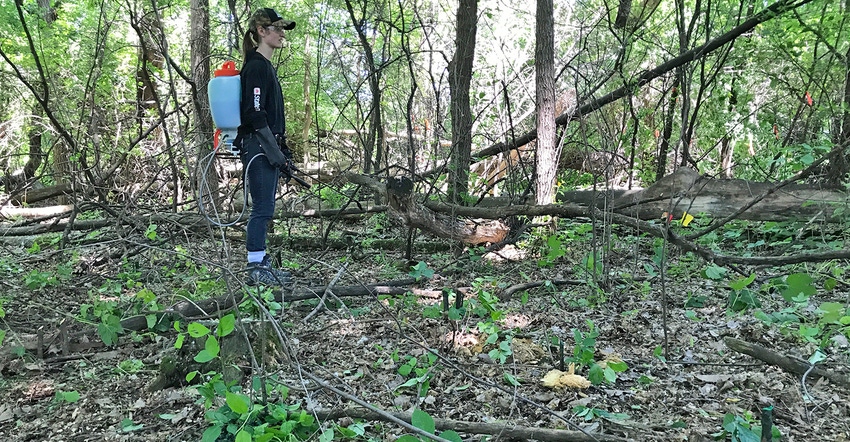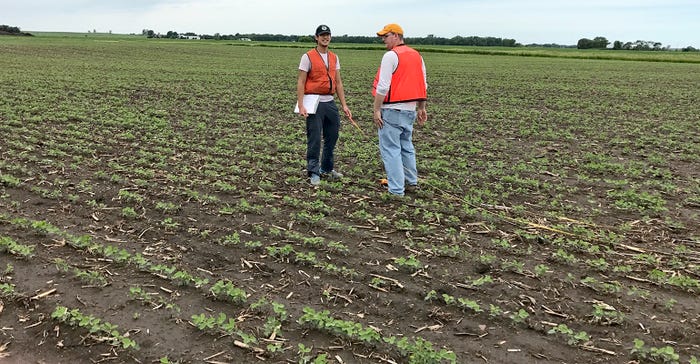
University of Minnesota scientists are in their second year of scouting for soybean aphids and buckthorn populations in fields and woodlands.
That’s because buckthorn has been found to serve as an accommodating overwinter host for aphid eggs.
Last year, Marcella Windmuller-Campione, a U-M forest management specialist, worked on the research project, which involved 23 soybean fields, and adjacent woodlands and hedgerows offered by farmers who volunteered to participate.
To date, there has been limited research exploring the relationship between buckthorn density and soybean aphid populations. Some research has been done in Ontario, along with this project in Minnesota.
After evaluating the 2017 data, Windmuller-Campione says there is a relationship between the two.
“We’re seeing a trend of increasing densities of aphids with high buckthorn,” she says.

HEAD COUNT: University of Minnesota grad students are shown conducted early-season sampling of soybean fields for soybean aphid last year. The sampling was part of a research trial that looked at the connection between aphid numbers and buckthorn densities.

Buckthorn abundance in the 23 Minnesota fields was denser than in Ontario. In Minnesota, average buckthorn density was 1,228 buckthorn stems per acre, compared to Ontario’s 283 stems per acre. Density in Minnesota went as high as 7,863 buckthorn stems per acre.
Soybean aphids were found at all sites, located mainly in central and southern Minnesota. More soybean aphids per plant, on average, were recorded later in the summer compared to early summer — 19 versus four aphids per plant, respectively. Overall, soybean aphid numbers per field were low, she notes.
Second-year study
This year, around 30 farmers have volunteered their fields and woodlots for the study, which is funded by the Minnesota Soybean Research and Promotion Council. Two student field technicians will visit farms twice this growing season to do all the necessary sampling and data collection. Information they gather about aphid numbers and woodlot species will be shared with landowners, as it was last year.
Windmuller-Campione says this year they are also experimenting with different ways to remove buckthorn. At the university’s Rosemount Research and Outreach Center, they did the traditional cut-and-spray to eradicate it. They also will experiment with the girdle method on larger plants to see if girdled plants might be more attractive to aphids and serve as trap trees.
“We’re really thankful for our great partners in this project — all the farmers, Minnesota Soybean and all the support from the university,” Windmuller-Campione adds. “We need as many people as possible involved.”
Buckthorn beginnings
According to the Minnesota Department of Natural Resources, common buckthorn was first brought to the state from Europe in the mid-1800s as a popular hedging material. Shortly after its introduction here, buckthorn was found to be quite invasive in natural areas. The nursery industry stopped selling it in the 1930s. However, many buckthorn hedges may still be found in older neighborhoods throughout Minnesota.
Three different cultivars of glossy buckthorn, also from Europe, were sold by the nurseries in the state. This buckthorn aggressively invades wetlands including acidic bogs, fens and sedge meadows.
Common and glossy buckthorn are listed as restricted noxious weeds in Minnesota. It is illegal to import, sell or transport buckthorn in the state.
Learn more about the buckthorn-soybean connection at U-M's webpage on what buckthorn and soybean have in common.
About the Author(s)
You May Also Like






